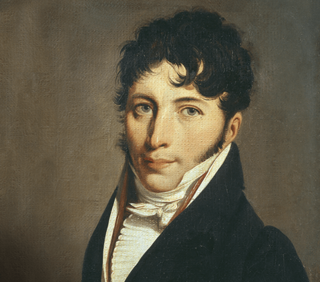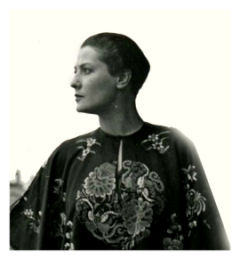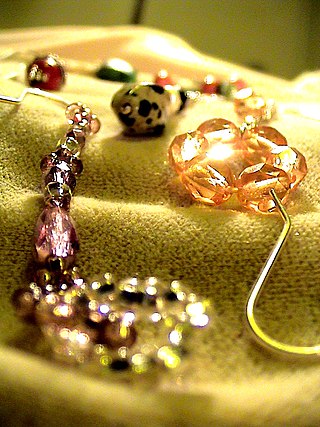Related Research Articles
Alessandra Martines is an Italian-French dancer and actress mainly working in the English, French and Italian speaking-worlds. She started young in ballet on opera stages in Switzerland, France, the United States and then Italy before becoming a lead on television for RAI captured ballets and entertainment shows in the eighties.

The House of Chaumet, founded in 1780, is a jeweller based in Paris.
Fred Joaillier, more commonly known as Fred, is a French jewellery and watch brand founded in 1936 by Fred Samuel in Paris and operated by the company "Fred Paris".

Marie-Étienne Nitot was a French jeweller, the official jeweller to the Emperor Napoleon, and the founder of the House of Chaumet.
Mdvanii was originally conceived as a conceptual art and fashion doll for adults by artist BillyBoy*. Since 1990 it has been a collaboration with his life partner, artist Jean Pierre Lestrade. The 25 cm (9.8 in) tall doll was originally made in a matte Caron make-up toned hard resin. Mdvanii debuted on February 14, 1989 in London, England.
Volume! The French Journal of Popular Music Studies is a biannual peer-reviewed academic journal "dedicated to the study of contemporary popular music". It is published by the Éditions Mélanie Seteun, a publishing association specialized since 1998 in the cultural sociology of popular music.
Andrea Cagnetti, known in the artistic world as Akelo, is an Italian goldsmith, designer, and sculptor. He is known for his research of the ancient techniques used in metalworking.
The French Union of Modern Artists was a movement made up of decorative artists and architects founded in France on 15 May 1929 and active until 1959.
Robert Mazlo is a French art jeweller and goldsmith of Lebanese origin who has been the head of the Paris-based Mazlo jewellery house since the late 1970s.

Suzanne Belperron (1900–1983), born in Saint-Claude, France, was an influential 20th-century jewellery designer based in Paris. She worked for the Boivin and Herz jewellery houses before the outbreak of World War II. Subsequently, she took over the Herz company, renaming it Herz-Belperron. Belperron had many important client, from royalty, arts and show business on both sides of the Atlantic.

Selim Mouzannar is a French-Lebanese jeweler and civic activist. He is the founder and CEO of Selim Mouzannar, his eponymous jewellery house and artisanal manufacturing corporation based in Beirut, Lebanon.
Émile-Séraphin Vernier was a French sculptor, metal worker, engraver and medalist. He was president of the Société des artistes décorateurs from 1905 to 1910. He later became an expert on antique jewelry in Egypt.

A bijou from the French bijou is an intricate jewellery piece incorporated into clothing, or worn by itself on the body.
BillyBoy* is an American artist, socialite and fashion designer who was a muse of Andy Warhol. Born in Vienna, he was adopted by a Russian couple who moved to New York City when he was four.

Dirce Repossi is an Italian jewellery brand founded in 1929, during the Art Déco era, by Camillo Repossi and Giusto Zeme.
Éric Holder was a French novelist.

Joseph Delteil was a 20th-century French writer and poet.

Edenly is a Switzerland based company that sells jewellery. It was founded in 2008 and is headquartered in Geneva, Switzerland. The company is a player in the diamond and gold jewelry segments.
Courbet is a French jewelry business founded in 2018 by Manuel Mallen and Marie-Ann Wachtmeister.

Jewelleryof the Berber cultures is a historical style of traditional jewellery that was worn by women mainly in rural areas of the Maghreb region in North Africa and inhabited by indigenous Berber people. Following long social and cultural traditions, Berber or other silversmiths in Morocco, Algeria and neighbouring countries created intricate jewellery with distinct regional variations. In many towns and cities, there were Jewish silversmiths, who produced both jewellery in specific Berber styles as well as in other styles, adapting to changing techniques and artistic innovations.
References
- Beth Bernstein (2015). If These Jewels Could Talk: The Legends Behind Celebrity Gems. Antique Collectors Club Dist. ISBN 1851498079.
- Claude Mazloum (1993). L'art de la joaillerie contemporaine. Gremese International. ISBN 88-7301-022-9.
- Claude Mazloum (1999). Jewelry Design in the 21st Century. Gremese International. ISBN 88-7301-310-4.
- Jocelyne Ruther (1971). Les Bijoux. Fayard.